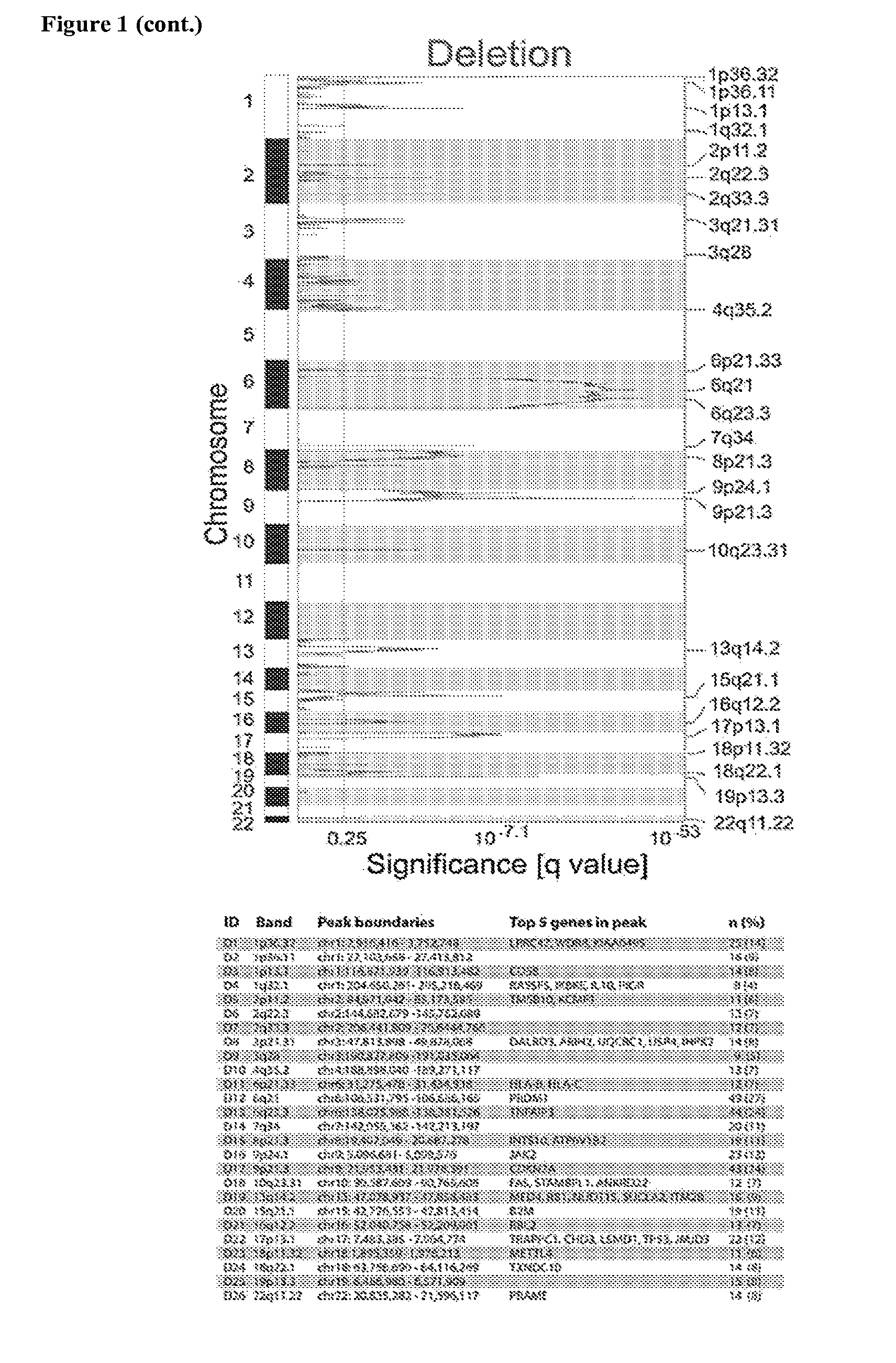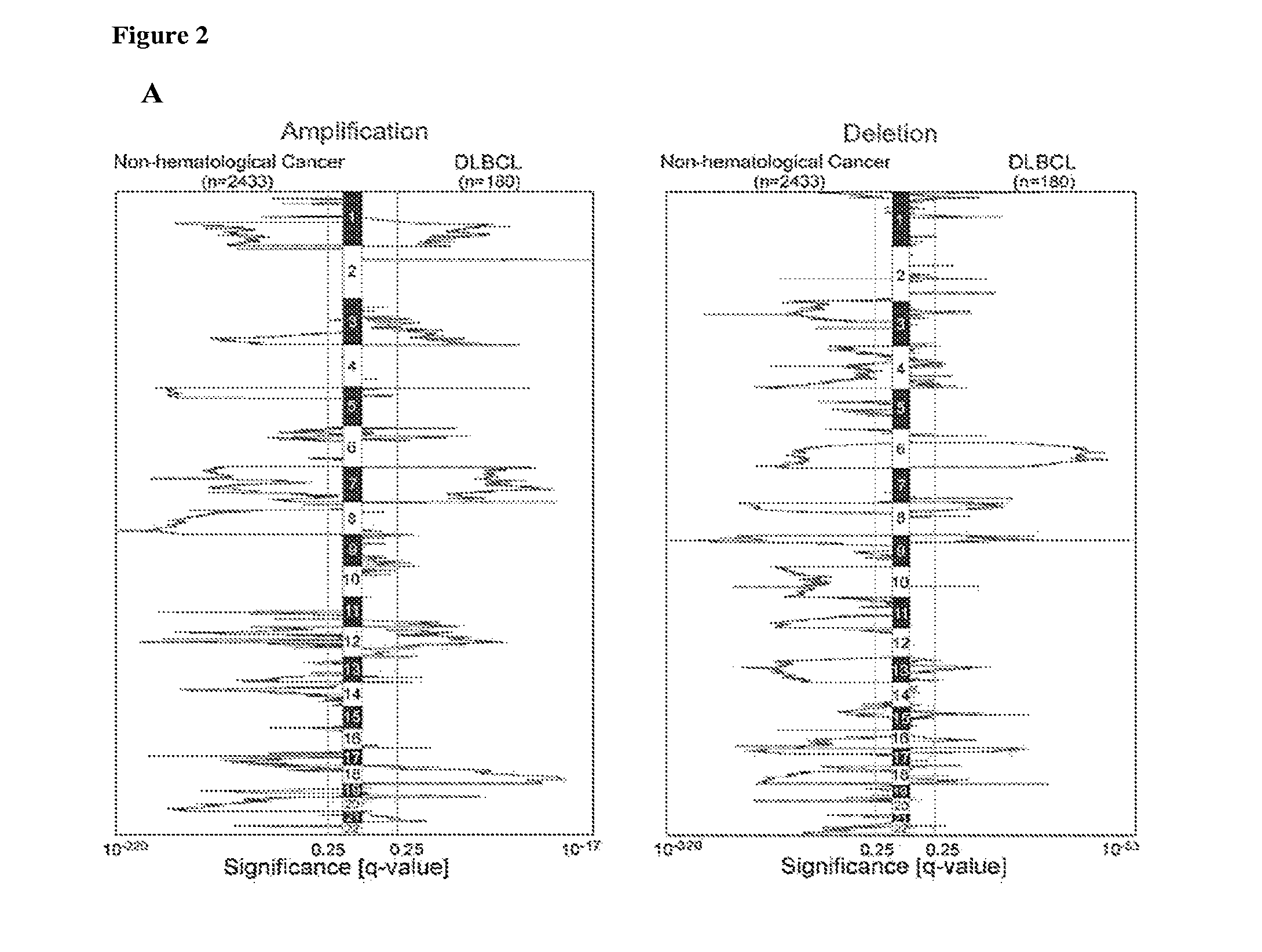Compositions, Kits, and Methods for the Identification, Assessment, Prevention, and Therapy of Cancer
a technology for cancer and preparation kits, applied in the field of preparation kits and methods for cancer identification, assessment, prevention, and treatment, can solve the problems of low resolution, lack of concordance between transcript abundance and copy number, and clinical model that does not provide insights regarding alternative treatment approaches for high-risk patients
- Summary
- Abstract
- Description
- Claims
- Application Information
AI Technical Summary
Benefits of technology
Problems solved by technology
Method used
Image
Examples
example 1
Materials and Methods used in Examples 2-14
A. Subjects and Primary Tumor Samples
[0300]High molecular weight DNA and total RNA were extracted from frozen biopsy specimens of newly diagnosed and previously untreated primary DLBCLs according to IRB-approved protocols from three institutions (Mayo Clinic, Brigham & Women's Hospital, and Dana-Farber Cancer Institute). For one subset of patients, informed consent was obtained (Mayo). For other patients, a waiver to obtain informed consent was granted by the local IRBs because otherwise discarded tissue was used. The series included 72 DLBCLs from patients who were treated with a rituxancontaining, anthracycline-based combination chemotherapy regimen (R-CHOP-like) and had long-term follow up; 68 of these patients had available information on all clinical parameters in the IPI (Table S6).
[0301]Specifically, frozen tissue sections (10-20×20 mm) were homogenized in 1 ml of G2-buffer supplemented with 2 ml RNase (Qiagen) using lysing matrix tu...
example 2
Recurrent Copy Number Alterations Mapped in Primary DLBCL
[0362]Recurrent CNAs in the 180 primary DLBCLs were detected using the GISTIC (Genomic Identification of Significant Targets in Cancer) algorithm. Within the identified regions of significant copy number (CN) gain or loss, narrower peaks of maximally significant CN change were identified. Forty-seven recurrent CNAs, including 21 copy gains and 26 copy losses, with frequencies of 4% to 27%, were identified (FIG. 1 and Table 1). The GISTIC-defined CNAs range from narrow focal alterations, such as amplification peak 2p16.1 to chromosome arm and whole-chromosome alterations, including gain of 1q, loss of 6q and gain of chromosome 7 (FIG. 1).
example 3
Comparison of CNAs in DLBCLs and Non-Hematological Cancers
[0363]To distinguish between CNAs that are unique to DLBCL and those that are found in other tumors, the DLBCL GISTIC analysis results were compared to that of 2,433 non-hematological cancers (Beroukhim et al. (2010) Nature 463:899-905). The CNAs in DLBCLs and the non-hematologic cancers were visualized with a mirror plot (FIG. 2A) and the CNA overlap in the two series was computed (Table 2). Seven of 21 (33%) regions of copy gain and 16 / 26 (62%) regions of copy loss were common to both series. Additional regions of copy gain exhibited partial overlap (FIG. 2B and Table 2). Examples of shared alterations include gains of chromosome 7 and chromosome 1q and loss of chromosome 6q, indicating a broader role for these alterations in multiple tumor types. In contrast, 9 / 21 (43%) regions of copy gain and 10 / 26 (38%) regions of copy loss were only identified in DLBCL, including gains of 2p16.1 and 19q13.42 (FIG. 2B and Table 2). Thes...
PUM
| Property | Measurement | Unit |
|---|---|---|
| survival time | aaaaa | aaaaa |
| fluorescent in situ hybridization | aaaaa | aaaaa |
| structure | aaaaa | aaaaa |
Abstract
Description
Claims
Application Information
 Login to View More
Login to View More - R&D
- Intellectual Property
- Life Sciences
- Materials
- Tech Scout
- Unparalleled Data Quality
- Higher Quality Content
- 60% Fewer Hallucinations
Browse by: Latest US Patents, China's latest patents, Technical Efficacy Thesaurus, Application Domain, Technology Topic, Popular Technical Reports.
© 2025 PatSnap. All rights reserved.Legal|Privacy policy|Modern Slavery Act Transparency Statement|Sitemap|About US| Contact US: help@patsnap.com



